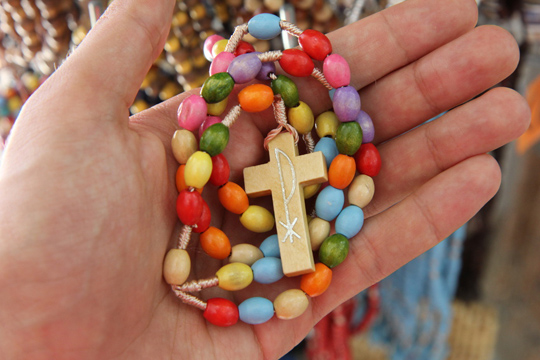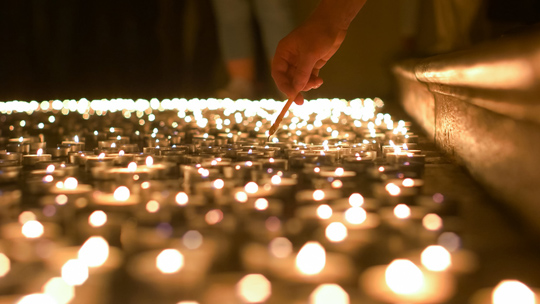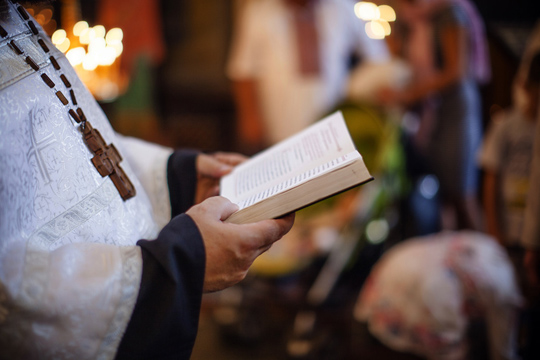Catholicism in Transition
Freiburg, Feb 01, 2018
The Christian churches appear to be suffering a dramatic loss of significance: More and more people in Germany are turning their backs to them. Enlightened Catholics in particular find it hard to accept clerical celibacy and the exclusion of women from ordained ministries. These practices no longer reflect the reality of modern life and therefore seem exceedingly dated – at least from a European perspective. However, this perspective appears itself to be long since dated in light of the great strides Catholicism has made in the past 100 years.

The colorful beads of the rosary symbolize the new diversity of Catholic Christianity. University of Freiburg researchers show that this diversity can provide the seeds for a new kind of unity. Photo: Adam Ján/Fotolia
A consideration of the global transformation of Catholicism, like in a current study by Junior Professor Dr. Bernhard Spielberg from the University of Freiburg’s Faculty of Theology and his three colleagues, can lead to astounding findings, and these findings can be fruitful not just for the Catholic Church but for society as a whole. A glance at the world map of religions shows that Christianity has spread at a breakneck pace, from 612 million believers in the year 1910 to 2.2 billion one hundred years later. In Europe the rise in the number of Christians has been comparatively modest, from 406 to 566 million. In other parts of the world, however, like the Americas, Asia, and Africa, the story is completely different. The Roman Catholic Church has had a great part in this development, growing from around 290 million members in the year 1910 to 1.2 billion today. Europe has long since given up its status as the center of the Catholic world: 39 percent of today’s Catholics live in Latin America, only 24 percent – down from 65 percent in 1910 – in Europe, 16 percent in sub-Saharan Africa, and 11 percent in Asia. “There has been a de-westernization,” analyzes Bernhard Spielberg. “The emphasis has shifted to the countries of the south and the east.”
With a membership encompassing 17.5 percent of the world’s population, the Catholic Church has developed into a transnational organization that truly merits the name of world church, says Spielberg. The fact that Pope Francis is the first holder of his office to hail not from Europe but from Latin America seems to provide living proof of the changed circumstances under which this world church operates. The man from Argentina finds favor with the European rank and file of the Catholic Church with his uncompromising stance on poverty, whereas his classical sexual ethics and his refusal to admit women into the priesthood are less popular. Francis hence does not fit any of the European categories, conforming neither to progressive nor to conservative stereotypes.
Breaking Free of Fixed Patterns
The idea of the Catholic Church as a unified whole had been unshakably lodged in the European consciousness for centuries: The same rituals, rules, colors, and forms served everywhere as a “corporate identity.” The liturgy was held in Latin worldwide up until the 1960s. And now? It is held in the language spoken by those in attendance. “The people don’t talk and sing the same anymore in church services. The priests don’t look the same anymore,” says Spielberg as a way of putting the meaning of globalization for Catholicism in concrete terms. What is left of the Church if the aspects that once formed its core no longer function? This is a question that also haunts everyone else who is affected by globalization and feels threatened by it: political parties, nations, citizens in cities and rural areas.

The idea of the Catholic Church as a unified whole long seemed unshakable: The same rituals, rules, colors, and forms served everywhere as a “corporate identity.” Photo: PavelPrichystal/Fotolia
Bernhard Spielberg and his group of junior researchers are studying how the Catholic Church is changing through its own globalization. After identifying general lines of global development, they decided to focus on three significant transformations. The doctoral candidates Anna-Maria Müller, Franziska Seidler, and Simon Ruscher are studying these transformations in three different parts of the world. “The different intellectual approaches and biographies are a valuable addition to our research project.” The individual case studies, which are based on ethnological field research, will lead to three theological dissertations.
A New Kind of Unity
Simon Ruscher took a look at multicultural parishes on the West Coast of the USA, where people from different backgrounds and cultures share the resources of a single parish. They are all Catholics, but they practice their faith in very different ways. The priest gives them the freedom to maintain their cultural independence without leaving them in a parallel society. Services in Spanish and Tagalog, the most common language in the Philippines, are held in alternation with services in English. Nobody is forced to adapt to the customary rituals of the majority and can feel for precisely this reason that they are part of a larger whole. The various communities are closely integrated into the structures, levels of leadership, and common feasts of their parish. The diversity can provide the seeds for a new kind of unity. In the opinion of the pastoral theologian Spielberg, shared parishes like these have the potential to become a learning field for society as a whole – in Germany as well, where integration is often identified with assimilation.
Franziska Seidler traveled to Kenya with the aim of studying the role of pastors in the East African country. A photo shows a pastor whose civilian clothing makes him almost unrecognizable as a priest talking with a group of women. They are taking notes on what he is saying. A sacral room with a cross and a picture of the Virgin Mary also serves as place of education. “As a religious authority figure, the priest is faced with great challenges in Africa,” explains Spielberg. “He becomes a cultural agent who bridges gaps where family structures and agrarian societies are changing and depriving people of the foundations of human coexistence.” The men move to the cities to earn a living, leaving the women and children behind. Globalization is changing people’s lives. Digitalization is highly developed in Africa and serves as a substitute for the poor infrastructure. The priests make use of mobile communication – but not to do missionary work: “They see it as their task to encourage people to take responsibility for themselves and to see to it that they can lead good lives.”

The liturgy was held in Latin worldwide up until the 1960s. Today it is held in the language spoken by those in attendance. Photo: elenakibrik/Fotolia
Individual Cultural Expressions
Finally, Anna-Maria Müller attempted in a region in Northeast India to determine what ideas of God developed among the Catholics after the West lost its cultural hegemony there. A typical example is the image of Christ on the cross: The enormous cross in the choir of the church is mounted on a massive base made of three tree logs leaning against each other. The Adivasi people regard trees as a spiritual medium. The symbol is hence a harmonious combination of the traditional and the Christian understanding of God. This demonstrates how the understanding of God is shaped by the particular culture of a society and the life situation of the people living in it. “The Church is not an open-air museum,” says Spielberg. “It develops its own cultural expression in every time and at every place. Otherwise it could not become relevant for our lives.” This reminds him of a quote by Raimon Panikkar, an advocate of inter-religious dialogue: “I left Europe as a Christian, I discovered that I was a Hindu, and I returned as a Buddhist – without ever having stopped being a Christian.”
The conclusion the young researchers have arrived at is that Catholic Christianity faces the challenge today – like in its early history – of understanding itself as an attitude toward life that takes on different shapes in different cultures and therefore requires different forms of worship and religious expression, “not primarily as a religious community representing a single world view that exists like a secret society independent of context.” This transition will likely be initiated less by the Church institutions themselves than as a result of the migration between the various local churches. From a political standpoint, the research group predicts that the Church could become “an agent of democratization in a multipolar world order.” The theologian Karl Rahner predicted in the 1960s that the Eurocentric Catholic Church would need an entire century to develop into a world church. There are still almost fifty years left.
Anita Rüffer

